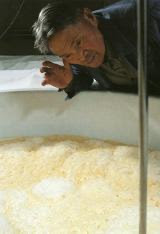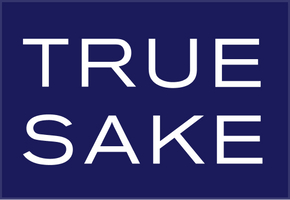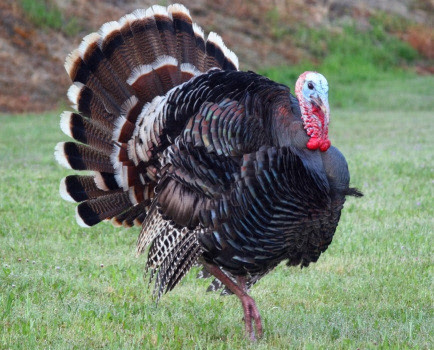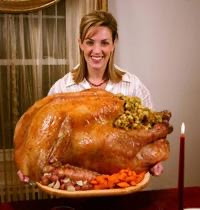
Turkey Sake – Looking Back Ten Years To True Sake Turkey Facts and Fun
I’m not sure if you ever look at our True Sake Newsletter Archives, but you should. Because you might stumble upon some funny stuff including the following article about turkey facts and sake facts. Written ten years ago, and still as relevant as ever, this piece highlights that you really should think about having sake at your Thanksgiving dinner table. In fact, you should baste your turkey with sake too! I’m pretty sure we gave a good recipe in one of our True Sake Newsletter November Issue – and yes it’s in the Archives.
Also, as we introduce our new Door Service at True Sake don’t forget to look for the sake bottles with Turkeys hanging around their necks. These tags designate the sakes that we feel would be great with the bird!
Herewith is the 2010 True Sake Newsletter’s November Issue: Enjoy and Gobble Gobble
True Turkey – Ten Fowl Sake Facts & Brews To Choose
Okay! It’s that time of the year again. Holiday season. And it’s time for you “sake drinkers” to do what? REMEMBER the sake people! Remember the sake! Herewith is a quirky union of facts of both sake and turkeys. Huh? Yup, this is a real gobbler!
-
Ben Franklin wanted to make the wild turkey, not the Bald Eagle, the national bird of the United States.
- Sake is not the real name for what you call sake. In Japan, all alcohols are referred to as “sake.” The real name for what you consider sake is “Nihonshu.” And the legal name for Nihonshu is “Seishu.”
-
Wild Turkey = “Meleagris Gallopavo”
- Koji Mold = “Aspergillus Oryzae” (The special brewer’s mold that is the engine of converting a starch to glucose.)
-
Wild Turkeys spend their days foraging for food like acorns, seeds, small insects and wild berries.
- Sake spends roughly 30 days fermenting in large vats via a technique called “Multiple Parallel Fermentation,” which means that the brew is saccrafying and fermenting simultaneously.
-
Wild Turkeys spend their nights in low branches of trees.
- Sake spends 6 months to a year in dark tank warehouses after fermentation to mellow the brew or take the edges off. This aging process is a technique that makes the sake more drinkable. (Not to be confused with unpasteurized sakes, which are released almost immediately.)
-
Male Turkeys also called “Tom Turkeys” or “Gobblers” puff up their bodies and spread their tail feathers. They grunt, make “gobble gobble sounds” and strut about shaking their feathers to attract females.
- Some older and more experienced tojis (head brewers) can tell how far along a fermenting batch of sake has progressed by listening to the bubbles, which form on top of the fermenting mash as yeast converts the sugars to alcohol, pop. They can also judge by the size of these bubbles how far along the fermentation has progressed.

-
After the female turkey mates she prepares a nest under a bush in the woods and lays her tan and speckled brown eggs. She incubates as many as 18 eggs at a time. It takes about a month for the chicks to hatch. Baby turkeys are known as “Poults.”
- After a month of fermenting, sake gets “filtered.” But in the west this use of the term “filtered or unfiltered” sake is a misnomer. When people call Nigori sake “unfiltered” sake, they are actually missing the point that the sake was charcoal filtered, thus it was filtered. If a sake is not run through a charcoal filter system it is called “Muroka” or “unfiltered” sake.
-
Wild Turkeys are covered with dark feathers that help them blend in with their woodland homes. The bare skin on the throat and head of a turkey can change color from flat gray to striking shades of red, white, and blue when the bird becomes distressed or excited.
- The true color of fermented sake is a mild yellow or golden color. As it ages it turns to a more amber shade and eventually goes to a hue along the lines of maple syrup or soy sauce. The charcoal filtration process strips the natural colors away producing an almost clear fluid. Nama or “unpasteurized” sake has a green tinge to it.
-
What do Turkey (the country in the Middle East) and the American bird have in common? A case of mistaken identity resulted in the American Turkey being named after the country. When the Spanish first found the bird in the Americas more than 400 years ago they brought it back to Europe. The English mistakenly thought it was a bird they called a "turkey" so they gave it the same name. This other bird was actually from Africa, but came to England by way of Turkey (lots of shipping went through Turkey at the time). The name stuck even when they realized the birds weren't the same
- The name of specific sakes can be a brand name, a family name, a brewery’s name, or a marketing name. For example a brewery in Nagano sells sake under their brand name (Masumi) and under their family name (Myasaka) and under a brand name (Yumadono).
-
The Turkey’s gizzard is a part of the bird’s stomach, which contains tiny stones that help to grind up food for digestion.
- Brewing rice is milled or polished to achieve certain size levels. To mill or polish rice large milling machines are used. Rice is dropped on millstones that grind away layer after layer of the rice. The rice powder that is removed then gets sucked away by large vacuums, and the now smaller rice grains go back through the process.
-
The Turkey’s “Snood” is the flap of skin that hangs over its beak. The “Snood” turns bright red when the turkey is upset or during courtship.
- Tsumami is the name for foods that go very well with sake. Usually folks either love these types or foods or hate them, as the flavors are very intense and are often quite salty and or pungent.
So there you have it, some seriously goofy Turkey and sake facts. (Thanks to kidzone.com for some of the turkey bits). Why did I write this? It’s easy; we want to subliminally remind you to think “sake” when selecting your Thanksgiving Day dinner libation. Did it work?
What about some specific brews that work well with Turkey? And why do they work?
This comes from a True Sake Newsletter piece I wrote in year’s past:
“I look for a robust acidity when I pair with meat, game or fowl. Add to that butter and other mouth filling flavors I like sakes that have some staying power in terms of flavor. I select fatter sakes that fill the mouth, rather than the light clean ones that fire right through the palate. Think meaty sakes for meaty flavors, and also use a larger glass than usual to mix up that acidity. Go with your big reds glasses, and don't worry about the next day big reds hangovers.”
2010 Thanksgiving List:
Kiminoi Yamahai Junmai Ginjo
Kamoizumi Junmai Daiginjo
Tengumai Yamahai Junmai
Kikuhime Yamahai Junmai
Narutotai Nama Ginjo Genshu
Born Muroka Junmai Daiginjo Nama Genshu
Tsukasabotan Junmai Daiginjo
Wakatake Junmai Genshu
2020 Thanksgiving List:
From Turkey Beau –
- Kaze no Mori Tsuyuhakaze Junmai Muroka Nama Genshu "Black Label Wind of the Woods"
- Tamagawa Yamahai Junmai Muroka Nama Genshu "Red Label"
- Takacho Bodaimoto Muroka Genshu "Regal Hawk"
- Takachiyo Junmai Origarami Nama “Green”
- Wakatakeya A Zen Ai Koshu "Love"
From Turkey Mei –
From Turkey Shin –
From Turkey Hiromi –
From Turkey Chika –


